
Santiago
July 1st - July 4th, 1999

Leaving the blistering center of Spain behind, we endured an all day train ride into the high country of Galicia. Much cooler than the rest of Spain, Galicia has always been the odd man out in Spain. With its own distinct language, Gallego (a blend of Castillian Spanish and Portuguese, with a bit of French tossed on top), and a decidedly different culture, one feels like you've left Spain altogether. Our first stop was Santiago, a very pleasant university town with a medieval center that's been declared a national monument. Cars are not allowed in the old part of town, so we settled on a room on the edge of the town's center and finally found a quiet (and cool!) place to crash in Spain.
The physical and cultural center of Santiago is the cathedral, the terminus of the Camino de Santiago. This is the 800 year old pilgrimage that, in Catholic lore, is believed to half one's time in purgatory. Starting at or near the border with France, thousands of believers make the trip every year. Below is a map of the 900 km journey. We were a bit taken back at the number of people who make the entire journey, even though one only needs to walk 100 km or ride a horse 200 km to "officially" complete the pilgrimage and reduce your time in heaven's waiting room.
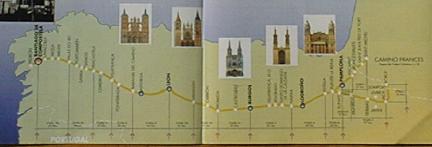
When one completes their pilgrimage, you top it off with the midday pilgrim's mass and the ritual rubbing of the shoulders of Saint James, located in the center of the cathedral's altar. For many pilgrims, reaching the plaza leading to the altar's entrance was a profoundly emotional experience, with many so moved they cried. Below left is a shot of a few pilgrims reaching the end of their journey. The center photo shows the cathedral at night; even when closed it was still a center of activity with musicians and others gathered around it. In the right photo, a sample of the seashell motif that one finds everywhere in Santiago. The seashell is the symbol of the pilgrim; this stems from the days of ancient Europe, wracked by war, yet desirous of allowing safe passage to pilgrims and other religious types. The pope Nicholas II and Kings Calixtus and Sanchez II decreed that all those who wore a seashell upon their hat were to be allowed safe passage, even through battlefields and hostile kingdoms. Anyone harming a pilgrim was decreed excommunicated by the pope and you know how nasty kings can be when crossed.
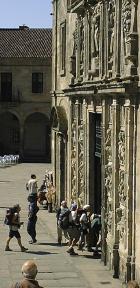 |
|
|
During the day the cathedral was packed -- standing room only. Santiago is the only cathedral we saw in Europe that is being used today as it was meant to be. The altar was a gold and silver affair, with four angels holding an ark adorned with saints and Jesus above the head of the Apostle James, who's remains are reported to have been found in Santiago in the 9th century. Below right is a photo of the giant incense urn (small silver vessel) used during the masses. Nearly a meter tall, it takes four or five priests to swing it from a pulley through the church. The reason given for such a large urn is that it takes lots of incense to cover up the smell of all those sweaty pilgrims.
|
|
The cathedral isn't of a single architectural style; rather, it was built over a period of 500 years and the style used in any new construction was that of the period. Some parts almost look Asian in design to our eyes. Below left shows one such tower and three of the old church bells. The bells in use are much older than any of the buildings and were once stolen by Moorish invaders and transported to Córdoba by Christian slaves. The Christians returned the favor a few hundred years later by conquering Córdoba and enslaving Moors to transport them back. The center photo shows a 12th century cross found in the delightful cathedral museum. Also found in the museum is this rightmost photo showing a unique statue of Mary feeding the baby Jesus.
|
|
|
The apostle James is the whole reason this cathedral is here in the first place. His tomb was supposedly found by a pilgrim in 813 when a vision led him to it. James image appears everywhere throughout the church and town; below is a 15th century pose done in wood showing all where it is written. Note the ever present pilgrim's cane and sea shells.
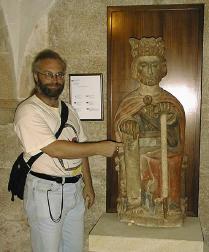
A City of Music
We visited Santiago during a special time. You see, the pope had scheduled a visit to Santiago on July 24th and the town was just starting to get revved up to receive his holiness. The town was sprucing itself up, and you could see Santiago's musicians were doing the same. Not a day passed where we didn't stumble upon a band of troubadours playing to an impromptu dance party, or an orchestra playing the old favorites. Galician music is unique in Spain, as the Celts once settled in this northern corner and their influence can be felt to this day. For example: one of the favorite Galician instruments is the bagpipe. We couldn't believe it when we first heard one. They're essentially Scottish in design, although slightly smaller and black in color. Accompaniment was often lutes and zither-like instruments, but we did come across some with a fair amount of brass.
|
|
|
Oh, and the Pope? We heard after we left Santiago that he canceled out on the trip -- much to the great disappointment of the people of Santiago, we're sure. The reason given in the newspaper is that he needed to go on retreat in order to work on peace in the Middle-east. Right. Last time he used that excuse it was because he was deathly ill and needed to duck the press for a while.
Our Finds in Santiago
We have to admit that by and large we were disappointed with Spanish cuisine. Outside of an excellent (and expensive) dinner in Toledo, most of the fare was greasy, heavy and far too oriented to meat -- mostly pork. The tapas we love in California simply don't exist here. You should have seen our ears perk up when we learned that Santiago has a reputably excellent vegetarian restaurant. O Cabaliño do Demo was a godsend to our pork-weary stomachs, with a light and delicious menu. Our only disappointment is they allowed smoking. The restaurant was very difficult to find, as they have no sign or address on the door, so here's a picture to guide you if you're ever up for veggie food in Santiago.

We were intrigued to learn that one of the owners is an American. He wouldn't tell us his name or let us take his picture, but he did let it slip that a lit sign on the first floor that read "eating well is the best revenge" is the title of his mother's cookbook. It was all a bit mysterious and we couldn't help but wonder if he was hiding out in this distant corner of Spain.
Our other find is of the Internet variety. H@ckers is a brand new cybercafe in the newish part of town, has a ISDN/Ethernet network configured correctly, and offers bargain basement rates and easy connectivity. They also have a CD Rom burner that (they claim) is available for backing up data. Unfortunately, when we visited it was lying in a little heap, covered with bits and pieces, and the owner was gone for the day. Shame, as we need to back up some half-gig of jpegs at this point. No beer or coffee, but we doubt they would complain if you brought your own.
Finisterre
Only a few hours away from Santiago and a favorite sight of pilgrims who've finished their trek across Spain lies Finisterre. Before the discovery of the New World, in the European mind Finisterre was considered one of the ends of the Earth (finis terrae). Past here lie dragons. So, of course, we had to check it out.
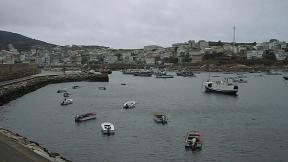
The town of Cabo Finisterre is a sleepy little fishing community, just starting to wake up to its tourist potential. The westernmost point of land is about 4 km from town, and contains a rather small old lighthouse (closed) and a modern sounding beacon. It also has a marine life museum, unfinished when we were there. The show is the big puddle to the west, or what one could see of it through the thick fog and mist. Below right, Jim assumes the classic Columbus pose and shows you where the New World lies.
|
|
What's that?
During our bus trip from Santiago to Finisterra we saw a number of mysterious structures, set on top of mushroom poles, and all topped off with crosses. Every building older than World War II or so had one. Yet none of the literature we had talked about them, and no where else in Spain or Europe did we see these small buildings. Can you guess what it is?
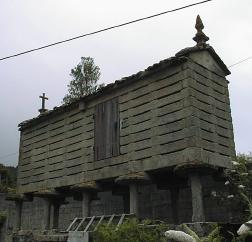
Answer: turns out they're drying sheds for corn and other grains. The wet weather in Galicia requires an enclosed space for drying, and the mushroom poles prevent small animals from crawling in and feasting. Although now-a-days, we often saw laundry hanging up in them.